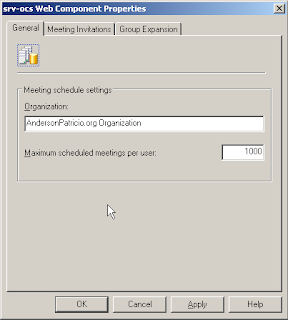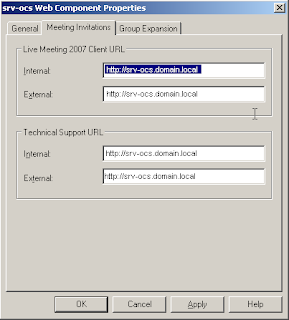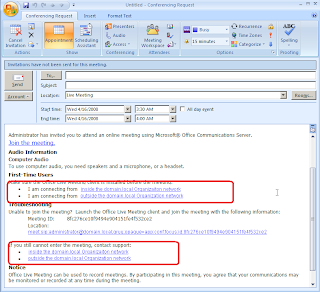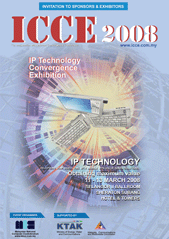Thursday, July 31, 2008
Custom Presence State in MOC
Tuesday, July 1, 2008
Call Forking and Simultaneous ring are they the same?
From My understanding True Simultaneous ringing is where you have 2 devices with totally different numbers. When someone calls your extension or DID it comes into the PBX and then your desk phone rings and your cell phone rings near simultaneously. the big key to this is that the numbers are different.
For Call forking it generally is referred to in situations where you have a desk phone and another device with the same phone number. i.e. desk phone and Microsoft Office Communicator. Both the desk phone and the MOC client have the same extension. The PBX forks the call to both devices at the same time and when one is picked up the other is released.
Now it all depends on who you talked to as to the definition.
Monday, June 16, 2008
Synchronize OCS address book manually
To work around this problem, you can create a simple .bat file to do a manual synchronization of the address book, to update the details of the users from Active Directory.
After synchronization, you still need to log off the Office Communicator client, and log back on to get the client to download the updated address book.Create a .bat file (absync.bat)
Put the following command in the file (update the path, if you haven’t used the default)
--oo--
"C:\Program Files\Microsoft Office Communications Server 2007\Server\Core\abserver.exe" -syncnow
--oo--
Troubleshooting Office Communicator Phone Experience (a.k.a. Tanjay) Update Server
http://blogs.technet.com/chlacy/archive/2007/11/01/troubleshooting-office-communicator-phone-experience-a-k-a-tanjay-update-server.aspx
Thursday, June 5, 2008
MOC: Outlook Integration Error
A Group Policy stting exists to correct this issue.
Read more here: http://support.microsoft.com/default.aspx?scid=kb;en-us;951644&sd=rss&spid=11402
Office Communications Server 2007 Visio stencil
You can get it here: http://www.microsoft.com/downloads/details.aspx?familyid=543705F6-D02A-436E-8B34-5C796550022A&displaylang=en
Please note:
If the stencils are missing when you open the visio document, follow these steps:
- Open the template in Visio.
- Click File, and then choose Shapes.
- At the bottom of the Shapes menu, choose Show Document Stencil.
Yahoo! and MSN (Windows Live) Public IM Connectivity changes
Read more here: http://communicationsserverteam.com/archive/2008/05/23/193.aspx
New Communicator Add-in for Outlook
In the meantime, here's what's new followed by some of my other thoughts...
Fixes & Updates:
- UI
- Created a TreeView instead of ListView.
- This allows collapsible\expandable groups, just as in Communicator. I think this is a better approach than having an option to display certain groups.
- Smaller UI details.
- Fix UI for 120 DPI
Functionality
- Allow filter of Offline & Away users. Will redisplay users when they are available again or will hide users if they are away or offline. Dependant on the you setting the filter.
- Will display groups that contain a “~”
Limitations due to API
- The API doesn’t give me access to Access Level or Distributions List.
- The API doesn’t give me access to the Recent or Other Contacts Groups.
Bugs
- The Show\Hide button doesn’t always respond.
- “Out of Office” is being considered as Away instead of Offline.
- Graceful error handling, IE if Communicator isn’t signed in.
Install Instructions (Uninstall Previous Version1.)
- Extract it the zip to some where besides the desktop. I’m using ClickOnce for installation, so the install should go somewhere you want it to reside.
- Close Outlook
- Run the setup.exe as Administrator. It will require .NET 3.5 & VSTO 3.0 Runtime. The installer will help you out there.
- During installation it will say it’s not from a Trusted Publisher as I do not have a certificate for this installation. Click Ok.
- Open Outlook
Office Communications Server 2007 R2 Rumors
Thursday, May 29, 2008
WebMessenger extends Microsoft OCS to Nokia users
WebMessenger has added support for Nokia handsets to its messaging middleware platform, which enables a wider range of corporate phones to be used with Microsoft Office Communications Server (OCS) for mobile presence and messaging functions.
Read more at http://www.itweek.co.uk/itweek/news/2217568/webmessenger-extends-microsoft (by Daniel Robinson, IT Week, 27 May 2008)
Changing Live Meeting invation information in OCS 2007
- Open Microsoft Office Communicaton Server 2007 console
- Expand Forest - <Domain name>
- Expand Standard Edition Servers
- Expand <OCS Pool Name>
- Right click on <Domain name>,click on Properties and then clickon Web Conferencing Properties
- In General tab, fill out with your organization name as shown in the figure below

We can also modify the URL's that go with the invitation. To do that click on Meeting invitations and change the internal and external URLs.

Let's try our new configuration, if you have the Live Meeting add-on installed, create a new Live Meeting and you will see your company name and your URLs in the invitation.

IIMF on OCS 2007
- Open Microsoft Office Communications Server 2007
- Expand Forest
- Expand Standard Edition Servers
- Right click on server name and click on Application Properties and then on Intelligent IM Filter

- Check Enable URL Filtering and now we have some options to define such as: If we want to block all hyperlinks that contains extentions defined in the File Transfer Filter tab, if we enable local intranet URLs.
In our post we are going to allow IM that contain hyperlinks but we will add a banner into each message and at the botton and instead of a link the user will receive a plain text. We are also able to chose some prefixes that the IIMF filter will be blocking.

Let's do a test, the user administrator as shown in figure bellow will send a link for another user.

The user that receive the IM will receive the link with a friendly warning about the link and the link will receive a caracther "_" in front of the http://. It means if the user really wants to access that website, he have to copy the content and open it in a web browser.
Tuesday, May 27, 2008
Notes for Communicator Web Access
One Server for Both Internal and External Users In order to deploy all users on a single computer, you must run IIS 6.0 in application isolation mode. For details about application isolation modes in IIS 6.0, see “Application Isolation Modes” at http://r.office.microsoft.com/r/rlidOCS?clid=1033&p1=appmodes.
- Two virtual servers cannot both share the same IP address and also listen on the same port; therefore, you must differentiate the virtual servers on your computer either by IP address or by port number. If both virtual servers use the same IP address, you will need to differentiate them by port number. Many proxy servers accept SSL traffic only on port 443, so you may need to manually configure the external virtual server to use port 443.
- You must configure your firewall or reverse proxy to map to the appropriate port for each virtual server.
- Although application isolation reduces security risk, it is still possible for the server to be compromised, which could affect both external and internal users. In contrast, using a separate external server would limit the impact of an attack on the external server to remote users only.
Required Software
The following software must be installed on the computer on which you will be installing Communicator Web Access:·
- Windows Server 2003 R2 SP2 or Windows Server 2003 with SP1 or later·
- Windows Installer 3 (included in Windows Server 2003 SP1 or later)·
- IIS 6.0· .
- NET Framework 2.0, including ASP.NET 2.0
Note
ASP.NET is automatically registered with IIS if the .NET Framework 2.0 is installed after IIS 6.0 is installed. If you install the .NET Framework first, you must manually register ASP.NET. For details, see
http://r.office.microsoft.com/r/rlidOCS?clid=1033&p1=kb325093.In addition, the following QFEs must be installed:·
- Microsoft Knowledge Base article 913297, “FIX: Error message when you try to run a Web application that was built by using the .NET Framework 2.0: ‘Overwhelming changes have occurred’,” at http://r.office.microsoft.com/r/rlidOCS?clid=1033&p1=kb913297. ·
- Microsoft Knowledge Base article 917283, “MS06-033: A vulnerability in ASP.NET could allow information disclosure,” at http://r.office.microsoft.com/r/rlidOCS?clid=1033&p1=kb917283.·
- Microsoft Knowledge Base article 922770, “MS06-056: Vulnerability in ASP.NET 2.0 could allow for information disclosure,” at http://r.office.microsoft.com/r/rlidOCS?clid=1033&p1=kb922770.
Certificates
- An MTLS connection will succeed only if the subject name for the MTLS certificate is the FQDN (fully qualified domain name) of the Communicator Web Access server
- SSL certificate. An SSL certificate is required on all Communicator Web Access servers and on any load balancer that is associated with an array of Communicator Web Access servers. The SSL (Secure Sockets Layer) certificate is used by clients that are connecting to the Communicator Web Access server. Each virtual server that is configured with HTTPS (HTTP with SSL) must have an SSL certificate. The CA that issues the SSL certificate for Communicator Web Access does not have to be the same one that issues the Office Communications Server 2007 SSL certificates or the MTLS certificates.
MTLS and HTTPS Certificate Configuration Requirements
Certificate field
ValueVersion 3
Template Duplicated Web Server
EKU Server Authentication (1.3.6.1.5.5.7.3.1)
Private Key Enabled for Export
Key Usage Digital Signature, Key Encipherment (a0)
- The subject of the Communicator Web Access certificate, which can be configured in the Communicator Web Access Manager, is always the FQDN of the Communicator Web Access server computer
- The subject name of the SSL certificate corresponds to the FQDN of either the server or the load balancer if one is presentOn a reverse proxy that is deployed in the perimeter network, the subject name of the SSL certificate corresponds to the FQDN of the reverse proxy
Ex:
Authentication
For remote users and for users of supported browsers that cannot use integrated Windows authentication, the forms-based authentication window will appear.
- · Optimizing IIS 6.0 scalability. IIS 6.0, running on the Microsoft Windows Server® 2003 operating system, includes a new architecture and new features to improve scalability on your Communicator Web Access server. For detailed information about optimizing IIS 6.0, see “Improving Scalability by Optimizing IIS 6.0 Queues” at http://r.office.microsoft.com/r/rlidOCS?clid=1033&p1=IIS6queue, “Improving Scalability by Optimizing IIS 6.0 Caches” at http://r.office.microsoft.com/r/rlidOCS?clid=1033&p1=IIS6cache, and “Additional Resources for IIS 6.0 Scalability” at http://r.office.microsoft.com/r/rlidOCS?clid=1033&p1=IIS6AddResScal.·
- Adjusting the IIS 6.0 user limit. By default, IIS 6.0 has a limit of 8,000 connections. This setting is configurable in the following registry key:HKEY_LOCAL_MACHINE\System\CurrentControlSet\Services\HTTP\ParametersTo increase the limit, create a DWORD entry named "MaxConnections" in this location and set an appropriate limit, allowing for a reasonable tolerance for peak periods. For example, if you want to allow 10,000 connections, you would probably set the value at double this number (20,000). For guidance, see the Microsoft Knowledge Base article “Http.sys registry settings for IIS” at http://r.office.microsoft.com/r/rlidOCS?clid=1033&p1=kb820129.
Magic Quadrant for Unified Communications 2007

This is the link to the web : http://mediaproducts.gartner.com/reprints/nortel/150273.html
Sunday, May 25, 2008
Guide on OCS Database tuning (SQL)
>If 32-bit version of SQL Server is running, enable Lock Pages in Memory (http://r.office.microsoft.com/r/rlidOCS?clid=1033&p1=LockPage) and enable AWE (http://r.office.microsoft.com/r/rlidOCS?clid=1033&p1=AWEon).
>These settings are not necessary if SQL server is 64 bit.
>Add a SQL Server trace flag for T4618 (http://r.office.microsoft.com/r/rlidOCS?clid=1033&p1=kbT4618)
1) Open SQL Server Configuration Manager
2) Select SQL Server instance, right-click, and then click Properties.
3) In the Advanced tab, click Startup Parameters.
4) Append ;-T4618 to the end of the Startup Parameters list and click OK.
5) Restart SQL Server.
Communicator Address book download (Galcontacts.db)
Typically, this delta file is based on the previous day. If the client is offline for a day or more, it determines which delta files it must download to get up to date. If the client is offline for more than 30 days, it attempts to download the full data file.
Storing this information in a local database reduces the time taken to synchronize information on the client computer with the latest information stored in Active Directory, thereby significantly improving the GAL search process. The location of this database is : Documents and Settings\\Local Settings\Application Data\Microsoft\Communicator.In the event of a download failure because of network connectivity or other issues, the client retries in time intervals that double on each failure (1 minute, 2 minutes, 4 minutes, and so on, up to a maximum of 64 minutes).
Any data that was downloaded before the failure is discarded, and the retry begins again at the beginning. If the failure persists for more than 24 hours, a warning is displayed, and an application event is added to the Event Log.
When the client logs in, it determines if it has been more than 24 hours since the last download. If so, then the current download occurs immediately. Otherwise, download is scheduled at 00:00 UTC (Universal Coordinated Time, also known as GMT).
Tracing in Office Communicator
Conversation History Settings
-- Save my instant message conversations in the Outlook Conversation History folder
-- Save my call logs in the outlook Conversation History folderare being published to the backend database, rtc.PublishedStaticInstance as binary, by the client.
<otheroptions>
<permissions> <personalinformationmanager>outlook</personalinformationmanager> <autoretrieveooffromoutlook>false</autoretrieveooffromoutlook> <publishcalendarpresence>false</publishcalendarpresence> <imautoarchiving>false</imautoarchiving> <calllogautoarchiving>false</calllogautoarchiving> <publishmeetingsubjectandlocation>false</publishmeetingsubjectandlocation> </permissions> </otheroptions> </publication> </publications> </publish>
Using Hardware Load Balancer for OCS 2007 Front-end Server
Thursday, May 22, 2008
Disaster Recover for OCS 2007
There are some solutions from others Microsoft team proposed which using backup and recovery method on the OCS 2007 server. Can it be automated? This has makes me to investigate more in my current lab. I've trying to create a auto service failover to DR server when the production server is down. I'll continue more after my lab test.
I've browse around, M Senthil Kumar blog has a discussion on backup OCS 2007 configuration guide. (http://blogs.msdn.com/mskumar/archive/2008/02/11/backing-up-ocs-2007-global-config.aspx)
Friday, April 25, 2008
OCS 2007 as main call manager
Wednesday, April 23, 2008
Problem with user not able to login via CWA
How to integrate OCS 2007 with Cisco Call Manager 4.x?

There will be some configuration need to be done at CCM as to route the inter-call between OCS client and cisco phone client.
Tuesday, April 22, 2008
OCS 2007 with Panasonic PBX TDA100

The PBX is using two PRI (ISDN card), for incoming source from service provider and the second PRI card for connection to media gateway. The PRI card has to be enable QSIG signalling to communicate with the media gateway (as media gateway will require min. QSIG signalling). With this, the normal fax machine will still able to be connected to the PBX system.
During the implementation, the two connections (service provider and to media gateway) are require to use coaxial cable (with BNC connector as standard). Due to media gateway are having RJ45 connection only, we uses balun which conver the coaxial (BNC 75ohm) to RJ45 connection (RJ45 120ohm).
PBX is configured as slave as accepting the source from service provider and media gateway would need to be configured as master.
Tuesday, April 1, 2008
Dialogic Media Gateway connects IP system to PSTN at Siemens Subsidary
Andreas Essing, (Director of the Microsoft Infrastructure Consulting Business at Siemens IT solutions and Services, Siemens AG) who help with the implemnetation and installation commented that "working with dialogic impressed us in terms of its high-grade product and excellent support during each phase of the project. we are already looking forward to being able to build on this positive experience in the future".
For more details, read the case study.
Saturday, March 29, 2008
Microsoft - Aspect in Contact Center
Last week, Microsoft has announced a multiyear global strategic alliance with Aspect Software to bring Unified Communications and Software Powered Voice to contact center sector. Understanding on the announcement; Aspect will integrate its.NET-based contact center suite (Aspect Unified IP) with Office Communication Server. This will certainly useful to both new and existing Aspect customers. In the announcement there is a missing component which addressing Microsoft’s Contact Center strategy via Unified Communication.
We still have not heard Microsoft will offer in terms of a contact center solution as a part of in conjunctions with its OCS offering. It’s clearly Microsoft recognizes how important it is to have some sort of contact center solution offering for customer that are looking into an Enterprise Unified Communication Voice solution but yet still has not disclosed any sort of contact center strategy to date.
Microsoft has several options clearly working with Nortel, a leader in the contact center space to provide the needs to contact center capabilities is one of the option. While Microsoft made it clear that the investment in aspect does not impact its relationship with Nortel. I’m pretty sure Nortel folks aren’t exited with this news. Another option is to acquiring a company in the contact center market, such as Aspect or possibly Interactive Intelligence. Of course there still some rumors that Microsoft will acquire Siemens Enterprise Communications, Nortel, or any others which if true, would provide Microsoft with the needed contact center capabilities and expertise. These are still rumors and so far no truth to any of them yet.
I believes that there’s a good change that Microsoft will leverage both Nortel and Aspect’s expertise and than offer its own contact center offering, (may be competing with both companies). Regardless what route Microsoft is moving to, it’s important that they articulate iuts contact center strategy for those companies that are looking to OCS as an enterprise voice solution.
Tuesday, March 25, 2008
Microsoft Office Communicator License Expired
Friday, March 7, 2008
OCS 2007 with Dual Focking Feature
Microsoft Real-Time Communications (RTC)
Session Initiation Protocol (SIP)
SIP has the following characteristics:
a) Transport-independent, because SIP can be used with UDP, TCP, SCTP & so on.
b) Text-based, allowing for humans to read SIP messages.
Voice over Internet Protocol (VoIP)
Companies providing VoIP service are commonly referred to as providers, and protocols which are used to carry voice signals over the IP network are commonly referred to as Voice over IP or VoIP protocols. They may be viewed as commercial realizations of the experimental Network Voice protocol (1973) invented for the ARPANET providers. Some cost savings are due to utilizing a single network to carry voice and data, especially where users have existing underutilized network capacity that can carry VoIP at no additional cost. VoIP to VoIP phone calls are sometimes free, while VoIP to public switched telephone networks, PSTN, may have a cost that is borne by the VoIP user.
Voice over IP protocols carry telephony signals as digital audio, typically reduced in data rate using speech data compression techniques, encapsulated in a data packet stream over IP.
There are two types of PSTN to VoIP services: Direct Inward Dialing (DID) and access numbers. DID will connect the caller directly to the VoIP user while access numbers require the caller to input the extension number of the VoIP user.
Tuesday, March 4, 2008
Call Hunting with OCS 2007?
Can Call Hunting feature work on OCS 2007? No... At the moment OCS 2007 will not able to support Call Hunting feature. If in the situation where its still require this feature, it has to be configure on the existing PBX system.
Monday, March 3, 2008
Internet Convergence Conference and Exhibition (ICCE) 2008
 The Malaysian National Computer Confederation (MNCC) will be organising ICCE 2008 on the 11-13th March 2008 at Sheraton Subang.
The Malaysian National Computer Confederation (MNCC) will be organising ICCE 2008 on the 11-13th March 2008 at Sheraton Subang. 